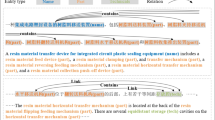Abstract
With the advancement of industrial informatics, intelligent algorithms are increasingly applied in various industrial products and applications. In this paper, we proposed a knowledge extraction framework for domain-specific text. This framework can extract entities from text the subsequent tasks such as knowledge graph construction. The proposed framework contains three modules, namely domain feature pre-trained model, LSTM-based named entity recognition and the attention-based nested named entity recognition. The domain feature pre-trained model can effectively learn the features of domain corpus such as professional terms that are not included in the general domain corpus. Flat named entity recognition can use the vector from pre-trained model to obtain the entity from domain-specific text. The nested named entity recognition based on the attention mechanism and the weight sliding balance strategy can effectively identify entity types with higher nesting rates. The framework achieves good results in the field of nuclear power plant maintenance reports, and the methods for domain pre-trained model and LSTM-based flat named entity recognition have been successfully applied to practical tasks.





Similar content being viewed by others
References
Akbik A, Blythe D, Vollgraf R (2018) Contextual string embeddings for sequence labeling. In: COLING, pp 1638–1649
Akbik A, Bergmann T, Blythe D et al (2019) FLAIR: an easy-to-use framework for state-of-the-art NLP. In: NAACL, pp 54–59. https://doi.org/10.18653/v1/N19-4010
Chen X, Qiu X, Zhu C et al (2015) Long short-term memory neural networks for Chinese word segmentation. In: EMNLP, pp 1197–1206. https://doi.org/10.18653/v1/D15-1141
Collobert R, Weston J, Bottou L et al (2011) Natural language processing (almost) from scratch. J Mach Learn Res 12(null):2493–2537
de Oliveira MV, de Almeida JCS (2013) Application of artificial intelligence techniques in modeling and control of a nuclear power plant pressurizer system. Prog Nuclear Energy 63:71–85
Devlin J, Chang MW, Lee K et al (2018) BERT: pre-training of deep bidirectional transformers for language understanding. In: NAACL-HLT, pp 4171–4186. https://doi.org/10.18653/v1/N19-1423
Gerard SN, Heching A, Keohane SM et al (2018) Knowledge reactor: a contextual computing work in progress for eldercare. Int J Electron Commun Eng 12(4):291–298
Guo Z, Zhang Y, Lu W (2019) Attention guided graph convolutional networks for relation extraction. In: ACL, pp 241–251. https://doi.org/10.18653/v1/P19-1024
Huang Z, Xu W, Yu K (2015) Bidirectional LSTM-CRF models for sequence tagging. https://doi.org/10.1061/(ASCE)CO.1943-7862.0000274. arXiv:1508.01991
Ju M, Miwa M, Ananiadou S (2018) A neural layered model for nested named entity recognition. In: Proceedings of the 2018 conference of the North American chapter of the Association for computational linguistics: human language technologies, vol 1 (long papers). Association for Computational Linguistics, New Orleans, Louisiana, pp 1446–1459. https://doi.org/10.18653/v1/N18-1131. https://www.aclweb.org/anthology/N18-1131
Katiyar A, Cardie C (2018) Nested named entity recognition revisited. In: Proceedings of the 2018 conference of the North American Chapter of the Association for computational linguistics: human language technologies, vol 1 (long papers). Association for Computational Linguistics, New Orleans, Louisiana, pp 861–871. https://doi.org/10.18653/v1/N18-1079. https://www.aclweb.org/anthology/N18-1079
Lample G, Ballesteros M, Subramanian S et al (2016) Neural architectures for named entity recognition. arXiv preprint arXiv:1603.01360. https://doi.org/10.18653/v1/N16-1030
Li J, Sun A, Han J et al (2020) A survey on deep learning for named entity recognition. IEEE Trans Knowl Data Eng. https://doi.org/10.1109/TKDE.2020.2981314
Li X, Meng Y, Sun X et al (2019) Is word segmentation necessary for deep learning of Chinese representations? In: ACL, pp 3242–3252. https://doi.org/10.18653/v1/P19-1314
Liu Z, Zhu C, Zhao T (2010) Chinese named entity recognition with a sequence labeling approach: based on characters, or based on words? In: Advanced intelligent computing theories and applications. With aspects of artificial intelligence, pp 634–640
Ma X, Hovy E (2016) End-to-end sequence labeling via bi-directional LSTM-CNNs-CRF. In: Proceedings of the 54th annual meeting of the association for computational linguistics, vol 1: long papers, pp 1064–1074. https://doi.org/10.18653/v1/P16-1101. https://www.aclweb.org/anthology/P16-1101
Peters ME, Neumann M, Gardner M et al (2018) Deep contextualized word representations. In: NAACL-HLT, pp 2227–2237. https://doi.org/10.18653/v1/N18-1202
Radford A, Narasimhan K, Salimans T et al (2018) Improving language understanding with unsupervised learning. Tech. rep, OpenAI
Shen Y, Ma X, Tan Z et al (2021) Locate and label: a two-stage identifier for nested named entity recognition. In: Proceedings of the 59th annual meeting of the association for computational linguistics and the 11th international joint conference on natural language processing, vol 1: long papers. Association for Computational Linguistics, Online, pp 2782–2794. https://doi.org/10.18653/v1/2021.acl-long.216. https://aclanthology.org/2021.acl-long.216
Sohrab MG, Miwa M (2018) Deep exhaustive model for nested named entity recognition. In: Proceedings of the 2018 conference on empirical methods in natural language processing. Association for Computational Linguistics, Brussels, Belgium, pp 2843–2849. https://doi.org/10.18653/v1/D18-1309, https://www.aclweb.org/anthology/D18-1309
Viterbi A (1967) Error bounds for convolutional codes and an asymptotically optimum decoding algorithm. IEEE Trans Inf Theory 13(2):260–269. https://doi.org/10.1109/TIT.1967.1054010
Webber J (2012) A programmatic introduction to neo4j. In: SPLASH, pp 217–218
Xue N (2003) Chinese word segmentation as character tagging. In: IJCLCLP, pp 29–48
Yang Z, Salakhutdinov R, Cohen W (2016) Multi-task cross-lingual sequence tagging from scratch. arXiv preprint arXiv:1603.06270
Yang Z, Dai Z, Yang Y et al (2019) Xlnet: generalized autoregressive pretraining for language understanding. In: NIPS
Zhang Y, Yang J (2018) Chinese NER using lattice LSTM. In: ACL, pp 1554–1564. https://doi.org/10.18653/v1/P18-1144
Zheng C, Cai Y, Xu J et al (2019) A boundary-aware neural model for nested named entity recognition. In: Proceedings of the 2019 conference on empirical methods in natural language processing and the 9th international joint conference on natural language processing (EMNLP-IJCNLP). Association for Computational Linguistics, Hong Kong, China, pp 357–366, https://doi.org/10.18653/v1/D19-1034. https://www.aclweb.org/anthology/D19-1034
Acknowledgements
This work was funded by the National Key Research and Development Program of China (2020YFB1707803). This paper has been extended from the original conference publication in the IEEE ICEBE 2021 proceedings.
Author information
Authors and Affiliations
Corresponding author
Ethics declarations
Conflict of interest
The authors declare that they have no conflict of interest.
Additional information
Publisher's Note
Springer Nature remains neutral with regard to jurisdictional claims in published maps and institutional affiliations.
Rights and permissions
About this article
Cite this article
Zhang, J., Qin, B., Zhang, Y. et al. A knowledge extraction framework for domain-specific application with simplified pre-trained language model and attention-based feature extractor. SOCA 16, 121–131 (2022). https://doi.org/10.1007/s11761-022-00337-5
Published:
Issue Date:
DOI: https://doi.org/10.1007/s11761-022-00337-5




